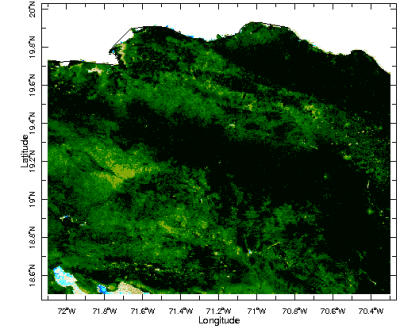Drought Insurance for Ganaderos in the Dominican Republic
By Sofía Martínez, Radost Stanimirova and Daniel Osgood
Since January, the northwestern Dominican Republic has experienced one of the worst droughts in 15 years. Early work by the International Research Institute for Climate and Society and its partners on a project funded by the United States Agency for International Development has shown the potential for using satellites to detect drought and design targeted insurance products for dairy farmers in the country. In collaboration with the Dominican farmers, project partners have created participatory exercises that are applicable to other projects around the world and that help design the index in accordance with the needs of the end users.
Santiago de Jesús Reyes, a ganadero, or dairy farmer, and the president of Aminilla’s Dairy Association in the northwestern Dominican Republic, wakes up at 4 a.m. every day to milk his cows. Like most other dairy farmers in the region, Reyes milks his cows in the morning and evening, spending the rest of the day working in the field. Reyes tries to keep food and water in reserve to maintain his cows at a nutritional level where they can produce milk even during drought periods. In addition to this year’s drought, he recalls a particularly bad drought in 2011.




“Many cows died here, and from then on we learned from the shocks the drought gave us,” he says. “We have learned to plant pasture, even with a small amount of resources.”
The 2011 drought taught Reyes and other dairy farmers in the Aminilla community that preventative actions implemented before the dry season can reduce the impact of a severe drought. These measures include planting pasture for the cows to graze on, harvesting water, storing feed in silos and preparing alternative feed using sugar cane derivatives and rice grains.
Climate-change projections from the Intergovernmental Panel on Climate Change indicate that the Dominican Republic is very likely to experience longer and more frequent droughts in the future, leaving producers increasingly vulnerable. During a recent trip to the Dominican Republic, members of IRI’s Financial Instruments Sector Team interviewed Reyes and other dairy farmers about their experiences with drought. The farmers said that during intense dry periods in the past, their production levels have decreased by 60-70% compared to normal levels. They believe that if they had implemented coping mechanisms in 2011, they could have mitigated the adverse impacts of reduced cattle feed supply on their milk production.
Even when dairy farmers implemented preventive actions in recent years, they could not completely eliminate their drought risk. Farmers can protect themselves against much of this remaining risk by purchasing insurance, which could provide payouts in times of intense drought to cover the their losses. However, many small-scale farmers haven’t had this option in the past. In January, the IRI conducted a study with 13 dairy associations on index insurance and its application for climate risk management. This work was part of the Climate Resiliency and Index Insurance Program, funded by the USAID office in the Dominican Republic. The program aims to help vulnerable agricultural communities access and use a tailored climate index insurance product as a risk transfer tool along with other adaptation measures to protect their livelihoods.
Unlike traditional crop insurance, which pays out based on consequences of weather on each farmer’s verified crop yields, index insurance pays out based on an objective measurement – in this case, satellite data that provides an indication of vegetative health (greenness) at a given time. If the measured greenness of a pasture is below a pre-specified threshold, then the insurance pays out. This innovation significantly lowers the insurance company’s transaction costs and risks, reducing insurance premiums and increasing accessibility. Index insurance will only pay out in the worst years, so it works most effectively alongside adaptation measures.

The DR CRII project uses Normalized Difference Vegetation Index (NDVI) imagery to trigger insurance payouts that can provide support to dairy farmers coping with low rainfall and reduced pasture. Image created with the IRI Data Library.
The aim of the index insurance study, which was designed with support from the Earth Institute’s Center for Research on Environmental Decisions, was to refine the insurance product according to farmers’ needs. Project staff first introduced the concept of index insurance to farmers in the Dominican Republic in October 2013. They gave the farmers the opportunity to test out the prototype insurance policies throughout the 2014 dry season. Farmers will be able to purchase a final commercial product later in 2014. The drought that hit northwestern Dominican Republic in early 2014 enabled the project partners to test the relevance of satellite data during a critical time, and confirm that satellite vegetation data was an appropriate data source for index design and more closely reflected farmers’ on-the-ground experiences than satellite rainfall data.





You must be logged in to post a comment.